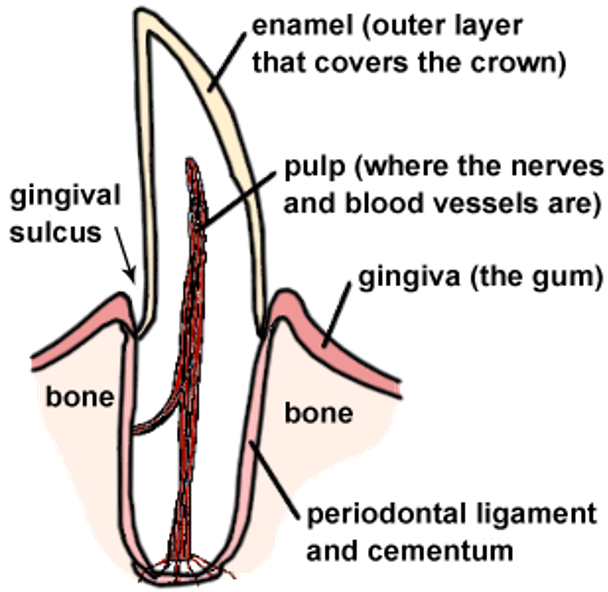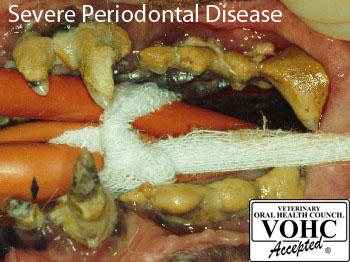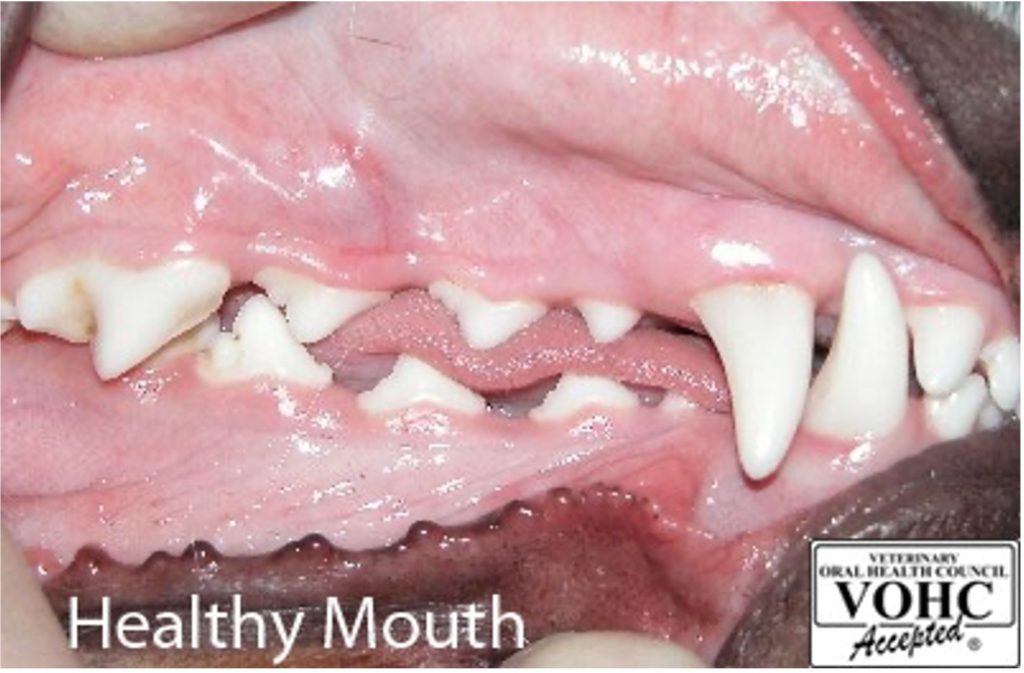Periodontal or gum disease, which literally means disease around (perio-) the tooth (-dontal), is the most common cause of early tooth loss in dogs and cats. Shockingly it affects over 87% of dogs and 70% of cats over three years of age. The disease, which is caused by the build-up of plaque on the teeth, not only leads to smelly breath or halitosis but also causes inflammation of the gums otherwise known as gingivitis. This occurs because the plaque becomes mineralised into tartar, a gritty material, which stops oxygen from reaching the teeth and allows harmful bacteria to build up, leading to tooth decay.
When the gums become inflamed, the gap between the gum margin and the teeth, which is called the gingival sulcus, gets deeper. This allows harmful bacteria to grow in this space and more plaque to develop below the gum margin.
As we can see in the diagram the tooth sits in a bone socket and is held in place by the periodontal ligament and the cementum or bone cement.
These harmful bacteria release toxins which cause further damage to the tissues. Although your pet’s immune system will try to limit this damage, it can still lead to damage to the periodontal ligament, cementum, and the bone, and in turn the tooth may become loose. The full extent of this damage can often only be appreciated through examination and dental X-rays taken under a general anaesthetic.

And even more concerning is that the bacteria from the mouth are picked up and transported by the bloodstream and can infect any other organs in the body posing a serious risk of disease in particular to the heart, liver, kidneys.
Because we believe good dental hygiene is so important to keeping your pet healthy we’ve included a 10% discount on all dental treatments and accessories for our Healthy Paws Club members.
How will I know if my pet has dental disease?
It is very difficult to detect the early stages of dental disease. Signs to look out for include: smelly breath, red inflamed gums, bleeding from the gums, damaged or discoloured teeth, pain around the mouth, rubbing the mouth, and even swelling on the face near the eye or discharge from the nostrils. Pets show pain differently to us so the disease is likely to be very advanced before they show reluctance to chew hard food or treats, or to eat on the worst affected side of their mouth or even to stop eating.

What can I do if I suspect my pet has dental disease?
We would recommend having your pet examined by a veterinary surgeon to assess the extent of the problem. The vet may advise a range of treatments, which might include descaling and polishing the teeth and if necessary removing any teeth causing pain. These procedures require a general anaesthetic and the vet will carefully weigh up the risks involved in this procedure against the benefits for your pet. Although any anaesthetic carries a risk, modern anaesthetics protocols have been designed to reduce this to a minimum. To reduce this still further the vet may suggest taking a blood sample from your pet before a general anesthetic is given to check the kidneys and look for active liver damage, and giving your pet intravenous fluids (a drip) on the day of the anaesthetic. During the dental procedure, the vet may also take dental Xrays to assess those areas of the teeth which lie below the gum and are out of sight.
What can I do to prevent my pet from dental disease?
Daily tooth brushing is the most effective way to prevent the build-up of plaque on your pet’s teeth with every other day brushing 60% less effective and brushing 4 times a week or less having no proven benefit at all.
Whilst you are more likely you are to succeed if your pet is young, it’s never too late to try.

Here are our 5 steps for tooth brushing success! Good luck!
Step 1 – Handling the mouth and face
- massage and handle the chin, upper and lower jaw for a couple minutes at least once a day
- make sure you reward your pet after massaging – use praise, affection and treats
- once your pet likes this (at least 1 week), graduate to next step – don’t go too fast!
Step 2 – Once you’re confident they are happy with Step 1 try placing your fingers in the mouth
- massage the gums and teeth with your finger, including the teeth at the back of the mouth
- again make sure you reward your pet – use praise, affection and treats
Step 3 – Massage the teeth and gums with a mildly abrasive material
- massage the gums and teeth use a mildly abrasive material such as a cloth, gauze or cotton wool
- again make sure you reward your pet after massaging
Step 4 – Soft tooth brush on the teeth and gums (no toothpaste)
- finger brushes work well for training
- remember to do all the teeth including those at the back of the mouth
- start the brush on the gums and brush away from the gums
- once again make sure you reward your pet after brushing
Step 5 – Toothpaste and a tooth brush
- check if your pet likes the taste. Why not try a few different flavours, if they’re not interested in the first one. Just like us they may have a preference! Whilst enzymatic toothpaste is ideal as 98% of cleaning action is related to abrasive action of toothbrush, it’s alright to not use toothpaste if you can’t find one your pet likes
- brush the gums and the teeth, scrubbing the brush from the gums and then off the tip of the teeth
- again make sure you reward your pet after brushing
If your pet really won’t let you brush their teeth please contact us about the range of other products available.
Remember, because we believe good dental hygiene is so important to keeping your pet healthy we’ve included a 10% discount on all dental treatments and accessories for our Healthy Paws Club members. Find out about all of the benefits here.


